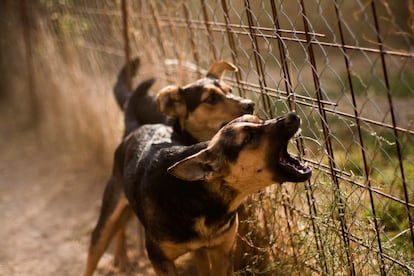Dogs are more aggressive when temperatures rise
A new study shows that on the hottest days canine attacks on people increase by 4%


Dogs have always had the distinction of being called man’s best friend. They are the favorite animal of many and the most common house pet. However, an aggressive dog can represent a problem for its owner, or whoever has a conflict with it. In that regard, the journal Scientific Reports published Thursday an article that claims that on days with higher temperatures and higher ultraviolet (UV) radiation, the probability of getting bitten by a dog increase.
The researchers analyzed data on dog bites in eight U.S. cities from 2009 to 2018, with nearly 70,000 reported bites. What they found is that the incidence of bites increased 4% on hot days, 11% when UV radiation was highest and 3% when ozone levels rose. The relationship between high temperatures and aggressiveness had already been confirmed in humans, rhesus macaques, mice and rats.
Although they have not established causality, Clas Linnman, the main author, states that the explanation could be related to the stress that the heat entails for these animals, besides the fact that it can also influence the behavior of humans towards them. Stefania Pineda, a specialist in animal behavior and professor at the Faculty of Veterinary Medicine of the Complutense University of Madrid (UCM), who did not participate in the study, agrees with Linnman. She also points out that on hot days, people go outside more and want to interact with dogs, which in turn may stress them more and result in an attack. “Heat-stress causes them anxiety and translates into aggression,” she remarks.
As for the UV radiation, although the causes have not been fully established, Linnman cites several investigations indicating that ultraviolet rays affect the levels of dopamine in the striatum of the brain (which is related to cognitive functions and regulation of movement). “There may be a link with the sensitivity of the systems of rewards for short-term actions,” explains the researcher.
Pineda states that aggressiveness is regulated by serotonin and dopamine. If UV radiation is shown to reduce dopamine levels, this would produce signs of anxiety, which can become aggression.
The researchers also observed a lower incidence of bites during the weekends. Linnman attributes it to both dogs and people being more relaxed and having more time to interact in peace. Pets spend a lot of time alone during the week and can get bored, which can stress them out; while on weekends they generally spend more time with their owners, do different activities and relax, explains the UCM professor.
Why does a dog bite?
One of the limitations that the authors found is that the records consulted did not include data on the dogs (breed, gender, castration or sterilization status) or the victims (severity of the attack, age, gender, familiarity with the animal or previous interactions). However, Pineda explains that the breed does not influence the risk of bite: “Many times, aggression is more common in small dogs than in large dogs.” In addition, she emphasizes that there is a lack of data on these incidents, because when the attack comes from a small dog, medical attention is not usually sought.
A dog bite can have consequences such as physical injuries, infections and even the transmission of zoonotic diseases that can be fatal, including rabies, says Mónica Boada, a veterinarian and predoctoral researcher at the Faculty of Psychology of the UCM, who is also not related to the study. In addition, it can psychologically affect the victim, adds Pineda.
The dangerousness of a dog’s bite depends on its size, explains the ethologist. If the breed is small there is risk of a bite, but the wound will not be comparable to what a Rottweiler can do, for instance. The large dog has more developed jaws, stronger teeth and a more muscular neck; due to all this, when it bites it keeps its mouth closed and a tear occurs. If the animal is small it bites and releases, so the wound will be milder, concludes Pineda.
When such an incident occurs, the victim is likely to know the animal. “We don’t usually interact with unfamiliar dogs, so the risk is greater with those of family or friends,” says Linnman. Also, they don’t just attack for no reason; it generally is a sign that something else is going on. A pathology must be ruled out and, if it is a behavioral problem, the owners should get in touch with an animal behavior specialist to work with the pet, both experts from the UCM agree. They can also be possessive and bite if a person tries to take their food or a toy they are protecting, explains the ethologist.
Dogs warn before biting. However, “humans are very bad at reading animals; we don’t understand their language,” says the UCM professor. Some signs that should be paid attention to are if it appears tense, if its hair is standing on end or if it is showing its teeth, says Boada. “After the signals comes the growl and then the bite,” concludes Pineda.
Sign up for our weekly newsletter to get more English-language news coverage from EL PAÍS USA Edition
Tu suscripción se está usando en otro dispositivo
¿Quieres añadir otro usuario a tu suscripción?
Si continúas leyendo en este dispositivo, no se podrá leer en el otro.
FlechaTu suscripción se está usando en otro dispositivo y solo puedes acceder a EL PAÍS desde un dispositivo a la vez.
Si quieres compartir tu cuenta, cambia tu suscripción a la modalidad Premium, así podrás añadir otro usuario. Cada uno accederá con su propia cuenta de email, lo que os permitirá personalizar vuestra experiencia en EL PAÍS.
¿Tienes una suscripción de empresa? Accede aquí para contratar más cuentas.
En el caso de no saber quién está usando tu cuenta, te recomendamos cambiar tu contraseña aquí.
Si decides continuar compartiendo tu cuenta, este mensaje se mostrará en tu dispositivo y en el de la otra persona que está usando tu cuenta de forma indefinida, afectando a tu experiencia de lectura. Puedes consultar aquí los términos y condiciones de la suscripción digital.








































